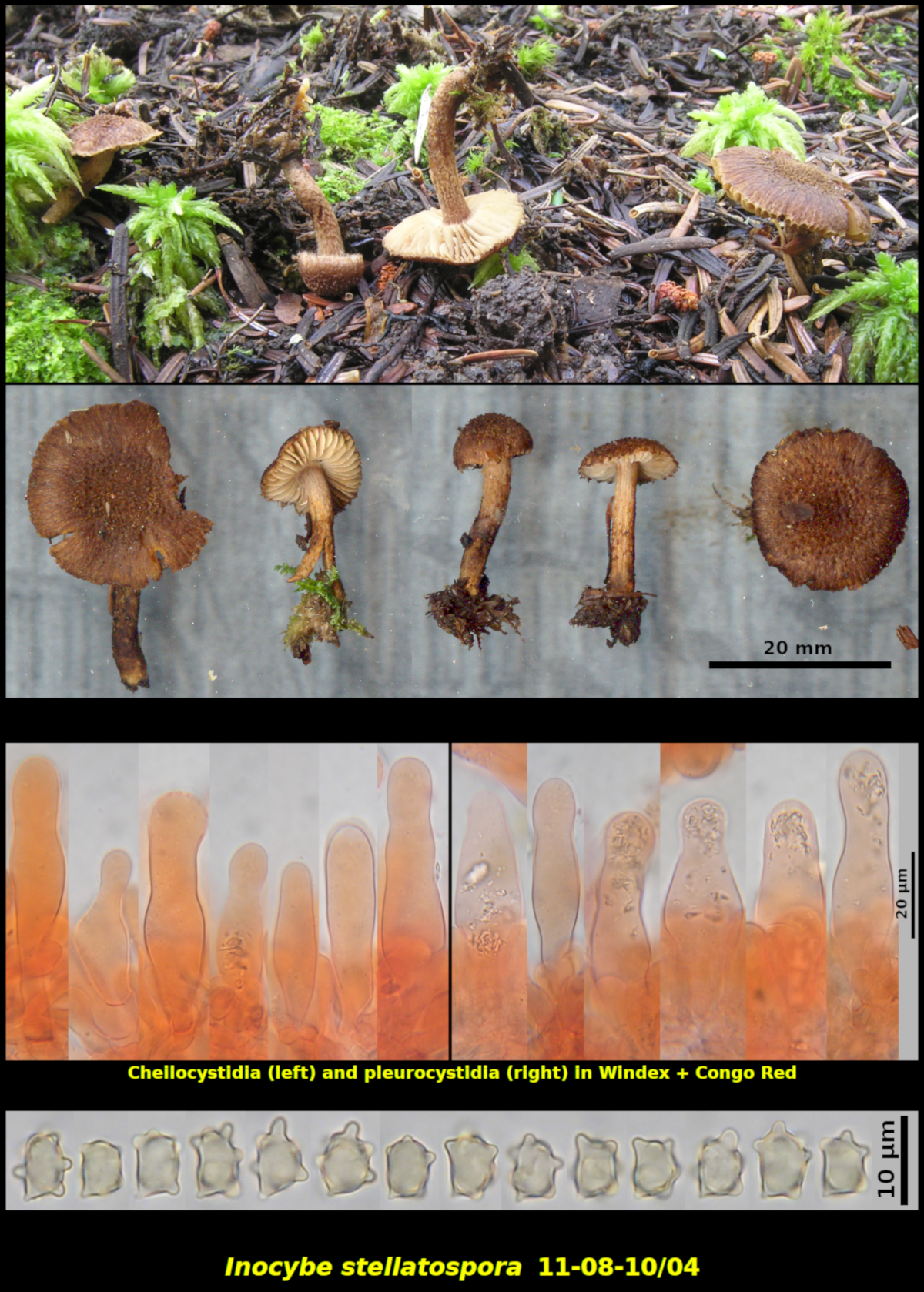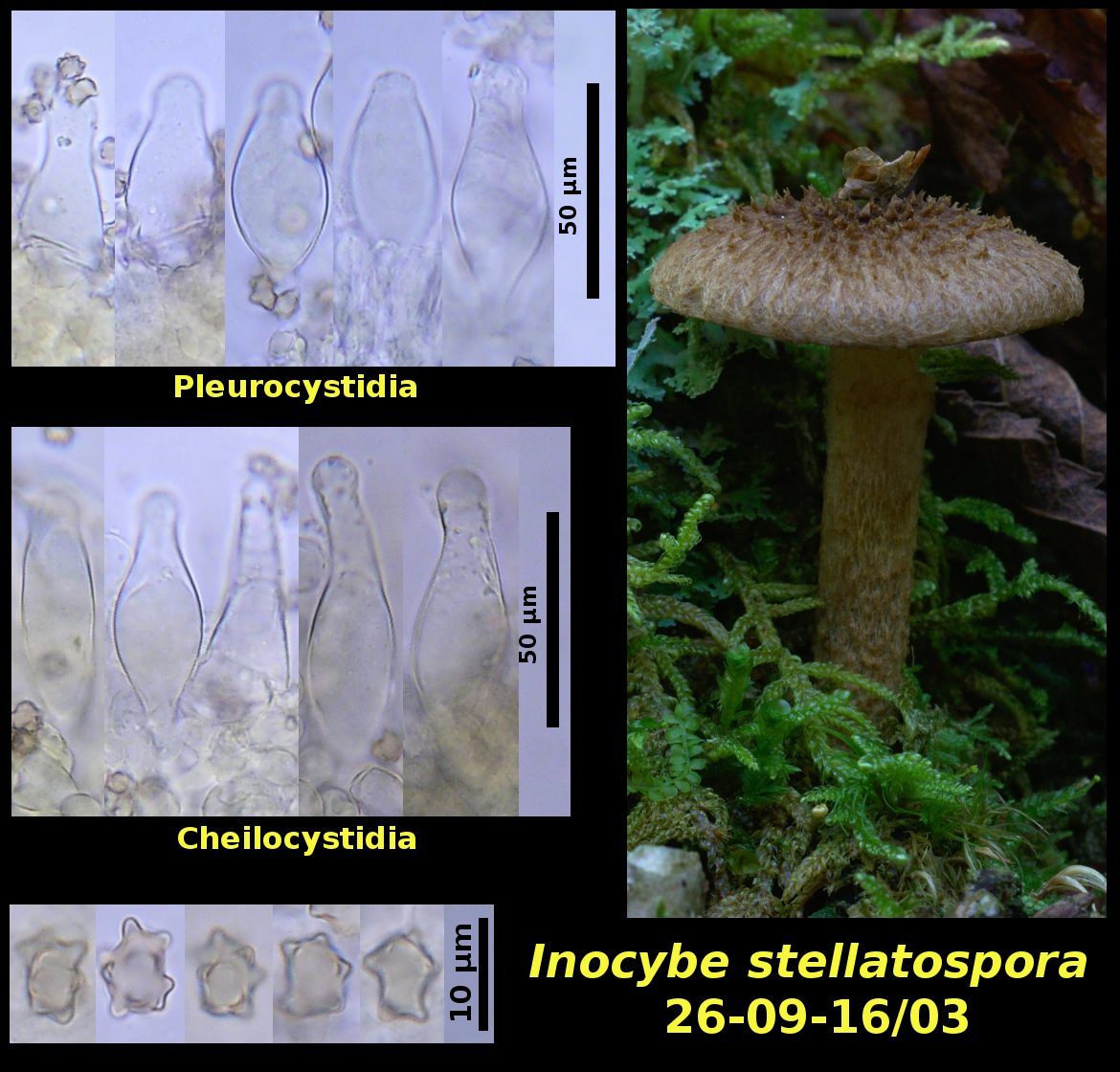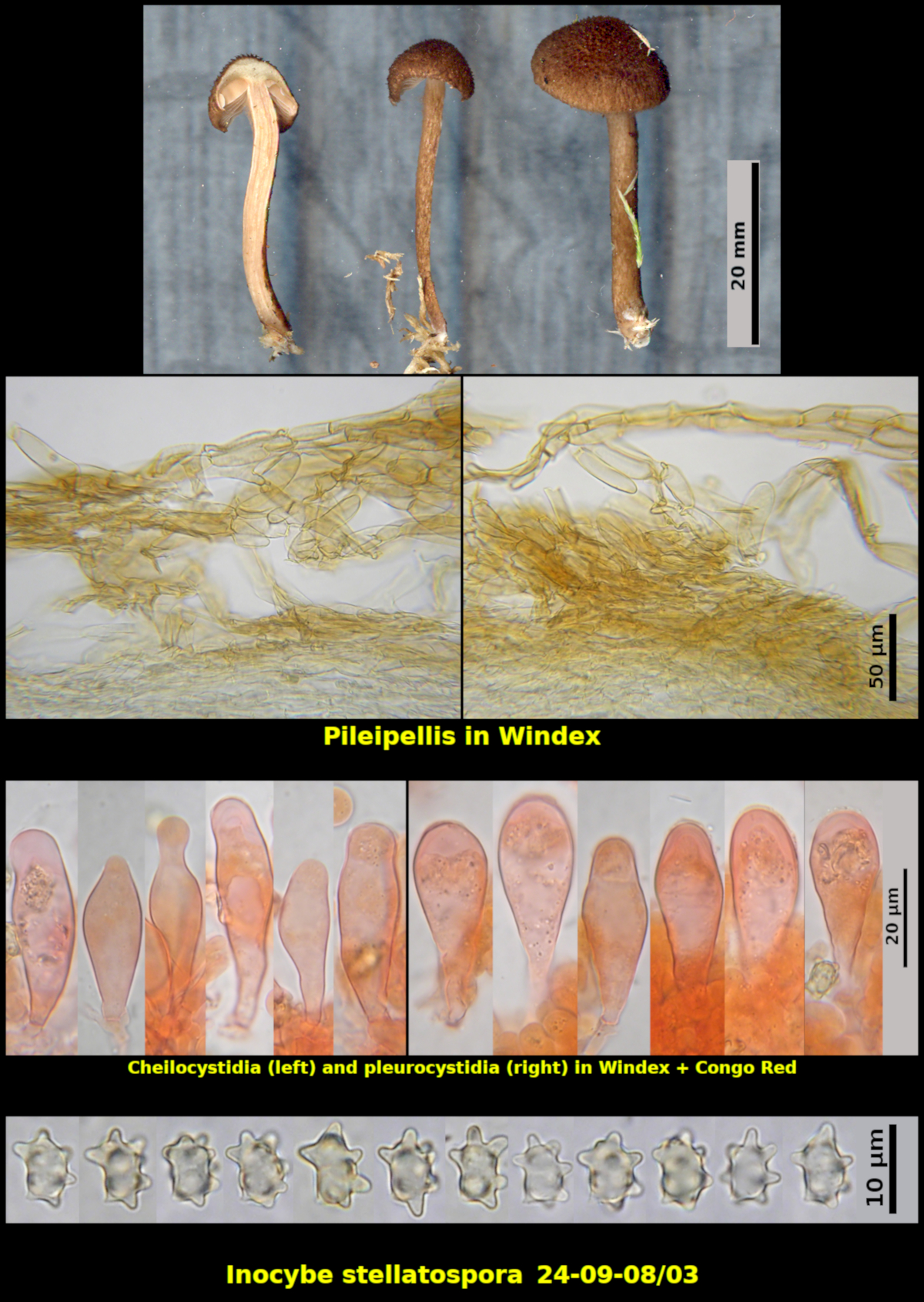Fleshy Fungi of New Brunswick >>
Inocybe stellatospora
Inocybe stellatospora (Peck) Massee



Three collections:
1. Gregarious amongst Sphagnum gametophytes and soil under Abies balsamea, Little Lepreau, New Brunswick (11-08-10/04).
Pileus convex at first, expanding to more broadly so at maturity, with an obscure rounded umbo or without an umbo, dry, squarrose-scaly, Brown to Dark brown (Methuen7EF4), with scales appearing darker than the ground colour, 11-21 mm in diameter. Stipe more or less equal, dry, covered with scales similar in character and colour to those of the pileus, Greyish orange (5B3), 17-22 X 2 mm. Lamellae white to Yellowish gray (4B2) at first, darkening as the spores begin to mature, subclose, adnexed, not marginate. Cortina not seen. Flesh Olive brown (4EF3) in the pileus, concolorous with the surface tissues in the stipe, with a pronounced but nondescript mushroom odour.
Basidiospores reddish brown in spore print, strongly nodulose with 11-12 nodules, darkening slightly in KOH, 6.4-8.8 x 4.9-6.9 μm, Q = 1.10-1.56 (average[34]: 7.5 x 5.9 μm, Q = 1.27). Cheilocystidia abundant but not forming a continuous sterile layer, ventricose to clavate to sublecythiform, thin-walled, with a thin gelatinous layer at the apex when viewed in KOH or Windex, 34-67 x 4.3-18.3 μm. Pleurocystidia abundant, ventricose to lageniform or sublecythiform, thin-walled, often with a thin gelatinous layer at the apex in KOH and Windex, 49-65 x 7.1-18.5 μm. Pileipellis a cutis, with surface layers recurving to form scales, composed of radially encrusted brown hyphae.
2. Gregarious among mosses on a highly decayed log, associated with Abies balsamea and Betula alleghaniensis, Fox Hill Road, Campobello Island, New Brunswick (26-09-16]03).
Pileus convex at first, expanding to more broadly convex, without an umbo, yellow brown (HSV40:50:60-70), squarrose-scaly, dry, 22 mm in diameter. Stipe equal, light orange brown (HSV50:20:100), darkening toward the base, densely scaly with subsquarrose scales, dry, 32 X 4 mm. Lamellae pale olive brown (HSV55:20-30:90), adnexed, subclose, not marginate. Flesh concolorous with the surface tissues in the pileus and upper part of the stipe, blackening in the lower part of the stipe, lacking a distinctive odour.
3. Gregarious (2) among sphagna under Abies balsamea, Picea rubens and Larix laricina, New River Beach Provincial Park, New Brunswick (24-09-08/03).
Pileus conic-convex at first, expanding to more broadly so at maturity, with an obscure rounded umbo, dry, strongly squarrose-hispid with stiff upright scales, Dark brown (6F5-6), 8-14 mm in diameter. Stipe equal, with Dark brown (6F5-6) scales over a Greyish orange (5B3) ground colour, with scales resembling those of the pileus, pruinose at the immediate apex, dry, 31-36 X 1.5-2.0 mm. Lamellae Greyish brown (6D3) at first, close, adnexed, not marginate. Cortina Brown (6E4). Flesh white (but possibly faded), Orange grey (5B2) in the stipe, with a weak mushroom odour.
Basidiospores forming a weak spore print, conspicuously nodulose with >12 nodules, with nodules often 2 µm or more in length, 7.6-10.7 x 6.3-8.3 µm, Q = 1.06-1.45 (average[32]: 8.8 x 7.1 µm, Q = 1.24). Cheilocystidia abundant and forming a sterile margin, lageniform to lecythiform, less commonly clavate to ventricose, thin-walled, without apical crystals, 27-49 x 10.8-13.9 µm. Pleurocystidia moderately abundant, scattered, mostly broadly clavate, less commonly sublageniform, thin-walled, often with a loose apical cap of soft material, 37-49 x 13.2-17.1 µm. Pileipellis a thick subascending to ascending cutis of brown encrusted hyphae, with a more compact brown subcutis.
Inocybe stellatospora is one of several species having a cap with upright (squarrose) scales and nodulose basidiospores. We have studied four other species in this group in eastern Canada: I. lanuginosa, I. leptophylla, I. subcarpta and I. teraturgus. All look remarkably alike in the field and can best be identified using microscopic characteristics. They can be distingushed by the following key:
1. Pleurocystidia lacking - I. leptophylla
1. Pleurocystidia present - 2
2. Cheilocystidia strongly ellipsoidal or egg-shaped. Basidiospores with conical nodules commonly up to 2 μm long - I. lanuginosa
2. Cheilocystidia mostly ventricose to lageniform 3
3. Stipe fibrillose to nearly glabrous, never scaly. Pileus often large - I. subcarpta
3. Stipe tomentose to scaly or squarrose-scaly. Pileus often less tha 20 mm in diameter - 4
4. Basidiospores with conical nodules commonly up to 2 μm or more long - I. stellatospora
4. Basidiospores with more rounded nodules rarely more than 1.5 μm long - I. teraturgus
The most striking features of I. stellatospora are the extremely nodulose basidiospores. When viewed in profile they often have the appearance of rooster combs, seen especially well in the second, seventh and eighth spores in the illustration of Collection 24-09-08/03 above. The pleurocystidia are rather variable in shape in our three collections but probably fit well enough within the current concept of the species.
Photos: D. Malloch (11-08-10/04, 24-09-08/03, 26-09-16]03).